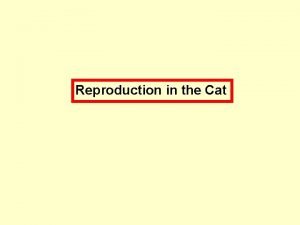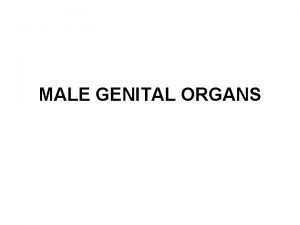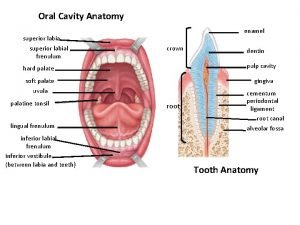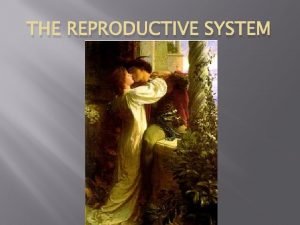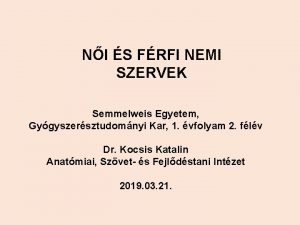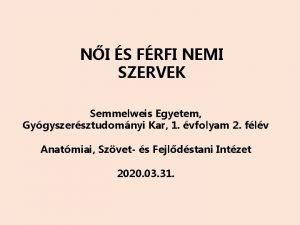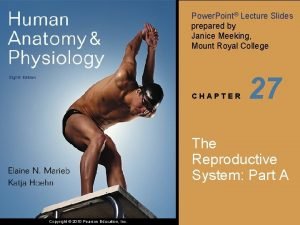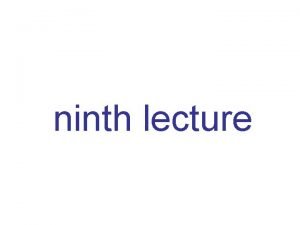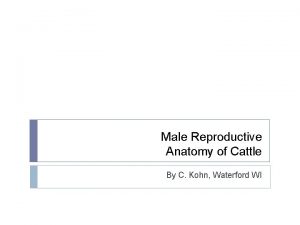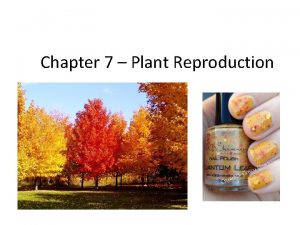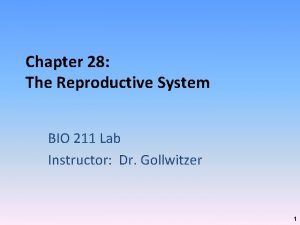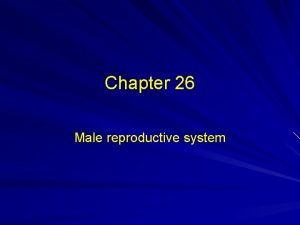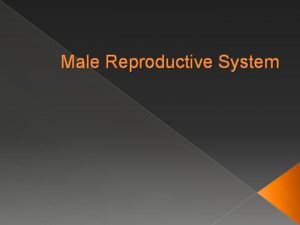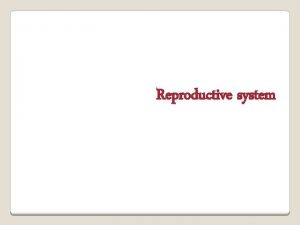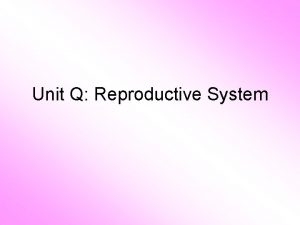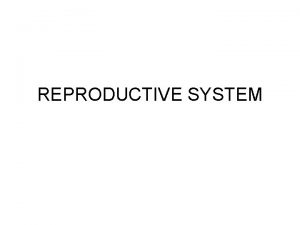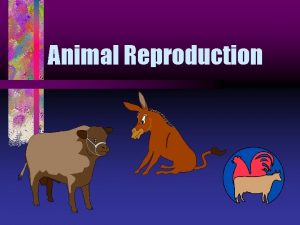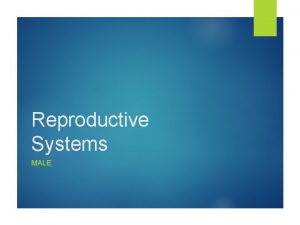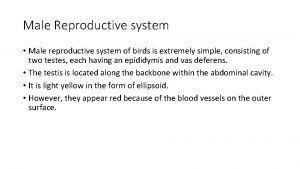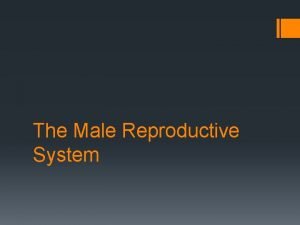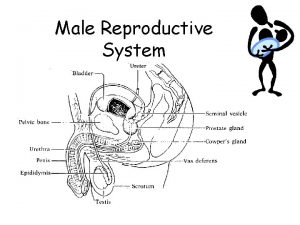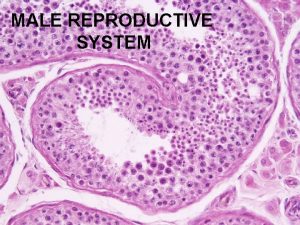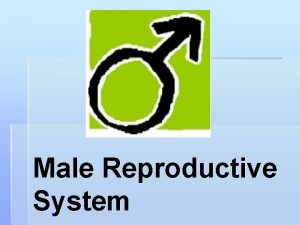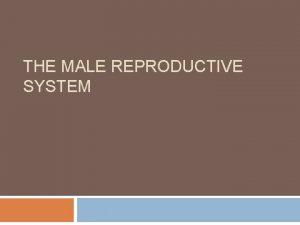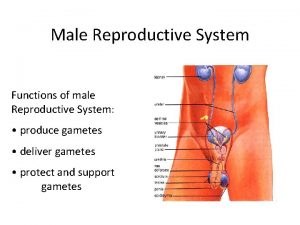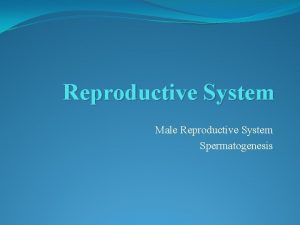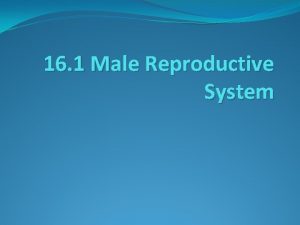The Reproductive System Male Reproductive System Testes Epididymis





























- Slides: 29

The Reproductive System

Male Reproductive System

Testes

Epididymis o o o Comma-shaped, tightly coiled tube Found on the superior part of the testis and along the posterior lateral side Functions to mature and store sperm cells (at least 20 days)

Vas Deferens o o o Carries sperm from the epididymis to the ejaculatory duct Passes through the inguinal canal and over the bladder Moves sperm by peristalsis Ends at ejaculatory duct unites with the urethra Vasectomy

Seminal Vesicles o o base of the bladder Produces a thick, yellowish secretion (60% of semen) n n Fructose (sugar) Vitamin C Prostaglandins (stimulate muscle contractions) Other substances that nourish and activate sperm

Prostate Gland o Encircles the upper part of the urethra o Secretes a milky fluid n o Helps to activate sperm Prone to cancer (like most glands)

Semen o Fructose provides energy for sperm cells o Alkalinity (base) of semen helps neutralize the acidic environment of vagina o Semen inhibits bacterial multiplication o 120 million/ml

External Genitalia o Scrotum. Maintains testes at 3°C lower than normal body temperature to protect sperm viability o dartos muscle o medial septum divides scrotum into two chambers o

Cont. . o Penis o Regions of the penis n Shaft n Glans penis n Prepuce (foreskin) n Often removed by circumcision



Sperm Only Human cell with flagellum. Head Contains DNA

Testosterone Production o o o o Produced in interstitial cells Functions- Stimulates reproductive organ development Underlies sex drive Causes secondary sex characteristics Deepening of voice Increased hair growth Enlargement of skeletal muscles Thickening of bones


Female Reproductive

Ovaries o Structure of an ovarian follicle n n Oocyte Follicular cells



Support of Ovaries

Uterine (Fallopian) Tubes o o o Receive the ovulated oocyte Provide a site for fertilization Attaches to the uterus Does not physically attach to the ovary Fimbriae Cilia inside the uterine tube slowly move the oocyte towards the uterus (takes 3– 4 days)

Uterus o o o Located between the urinary bladder and rectum Functions of the uterus n Receives n Retains n Nourishes Cervix – narrow outlet that protrudes into the vagina

Vagina o Serves as the birth canal o Receives the penis during sexual intercourse o Hymen

External Anatomy

Oogenesi s


Hormone Production by the Ovaries o Estrogens n Cause secondary sex characteristics o Enlargement of accessory organs o Development of breasts o Appearance of pubic hair o Increase in fat beneath the skin o Widening and lightening of the pelvis o Onset of menses

Mammary Glands o Present in both sexes, but only function in females…most of the time! n Modified sweat glands o Function is to produce milk o Stimulated by sex hormones (mostly estrogens) to increase in size

 Oogenesi
Oogenesi Cat epididymis
Cat epididymis Collum epididymis
Collum epididymis Epididymis seminiferous tubules
Epididymis seminiferous tubules The epididymis is a long coiled tube that sits atop the
The epididymis is a long coiled tube that sits atop the Spermiogenesis
Spermiogenesis Funiculus seminalis
Funiculus seminalis Function of vagina
Function of vagina Functions of reproductive system
Functions of reproductive system Female testes
Female testes Exercise 42 review male reproductive system
Exercise 42 review male reproductive system Uterus layers histology
Uterus layers histology Round ligament of uterus
Round ligament of uterus Female and male reproductive system
Female and male reproductive system Pearson education
Pearson education Luteinizing hormone in male reproductive system
Luteinizing hormone in male reproductive system Male reproductive system in plant
Male reproductive system in plant Art-labeling activity: the male reproductive system, part 1
Art-labeling activity: the male reproductive system, part 1 Male reproductive system information
Male reproductive system information Where is sperm stored
Where is sperm stored Cow male reproductive system
Cow male reproductive system Prostatic fluid
Prostatic fluid Male reproductive system plants
Male reproductive system plants Disease traductor
Disease traductor Cartilaginous fish vs bony fish
Cartilaginous fish vs bony fish Male reproductive system of pila
Male reproductive system of pila Fetal pig urinary system labeled
Fetal pig urinary system labeled Female part of a flower
Female part of a flower Figure 28-2 the female reproductive system
Figure 28-2 the female reproductive system Primary sex organ of the male reproductive system? *
Primary sex organ of the male reproductive system? *

